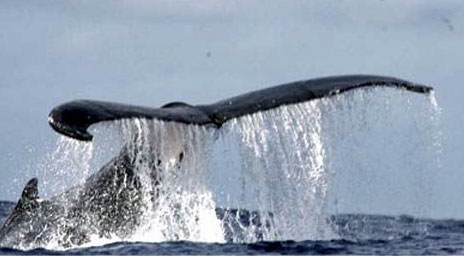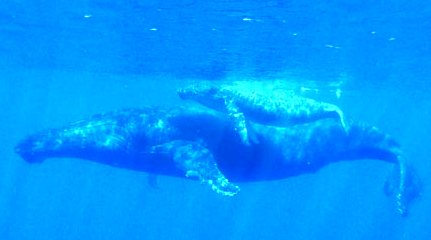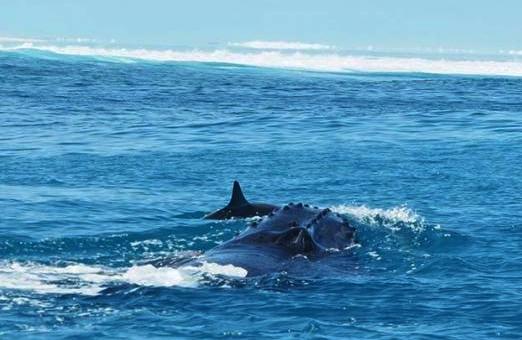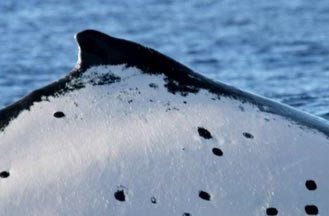

Photos: Greenpeace, Cook Islands News, Greenpeace
The whole of the territorial waters of the Islands - some 2 million square kilometres of ocean - is a designated whale sanctuary. And whichever island you're on, between July and October you have a good chance of whale watching. Atiu island guide, Marshall Humphreys was lucky enough to see a baby calf being born just off shore on Atiu. If you're IN RAROTONGA, THE BEST PLACES TO WATCH ARE....The Paradise Inn, The Fishing Club, the shore line in front of the main street through Avarua, Trader Jacks, Black Rock and the Edgewater Resort

It's not unusual to see many species...15 different types of whales were spotted off the coast of Rarotonga over a three day period in mid July, 2013. They included humpbacks which are likely to give birth in local waters. Other species enjoying the safety of the Islands waters were the sperm, short finned pilot, Culver's beaked whale, and Blainville's beaked whale.
New Zealand visitors, Miles and Kristine Patterson captured a stunning shot of a sunbathing humpback and its calf during a morning dive with Cook Islands Divers. They were near Papua Passage on the southern coast of Rarotonga.
The other photo is a rare sight from 2020...a young humpback frolicking with dolphins. Whale scientist, Nan Hauser has been studying whales for 30 years and she'd never before seen anything other than brief interactions between whales and dolphins and described the behaviour as "very unusual and intriguing".

VIDEO
Cook Islands News posted this video of whales off the coast of Rarotonga (opens in new window or tab)

In 2011, a fisherman reported a whale off the seawall on Rarotonga "with a real ugly head, logging or bobbing at the surface". Nan Hauser says that from his description it was the critically endangered Right Whale which has never been seen previously in Cook Islands waters. There are thought to be only about 30 left in the world. Another sighting was of an almost completely white whale (pictured here) which experts across Oceania say they've never seen before
Rarotonga-based Nan Hauser is internationally acclaimed for her studies of whales. And she's often seen during the whale watching season furthering her work in the waters around the islands. The Centre for Cetacean Research and Conservation, of which she's president, has its world headquarters here. She's spent more than 30 years studying them and has a special permit from the Prime Minister which allows her to get close to the whales for the purposes of her research. But she's concerned about others doing the same because they could harm or even drive the whales away from the Islands. To that end, she's helped provide some guidelines for responsible whale watching
BOATS
Approach slowly from the side, never closer than 100 metres (110 yards). Whales are free to approach you. It is acceptable to stop a boat 300 meters ahead and to one side of the whale and wait quietly for it to pass. NEVER approach a whale head on or directly from behind. NEVER approach, pursue or come between a mother with a calf. A whale with a young calf may protect her offspring aggressively if she feels threatened. Circling around any whales is forbidden. If there are 2 boats present, position yourself ‘one behind the other’ and stay together. Never have 3 boats around the whales or they head out to sea. Never separate a group of whales, cut off their path, or ‘box’ them in. Vessels should not be operated at high speeds around the whales. Avoid sudden or repeated changes in speed or direction. Never approach closely with fishing gear out. Leave a whale that seems disturbed by your presence
SWIMMERS AND DIVERS
Swimmers and divers are FORBIDDEN to approach whales or enter the water with a whale. If the whale approaches someone already in the water, enjoy the encounter but don’t swim toward the whale. Aggressive behaviour can occur when whales feel threatened or harassed underwater. Active whales may consider you a threat during their mating season when males compete for females and engage in rough battles
KAYAKS AND PADDLERS
Kayaks and paddlers should stay at least 100 metres away from the whales for passenger security, but the whales may very well be curious and approach you!
JET SKIS AND JET BOATS
Jet skis and jet boats must NEVER approach whales and should stay at least 300 metres away from the animals. The sound is damaging to their ears and interferes with their song and communication
FIND OUT MORE ABOUT WHALE RESEARCH AND CONSERVATION IN THE COOK ISLANDS
The Centre for Cetacian Research and Conservation has its own website with lots of information, photos and videos
. Click here